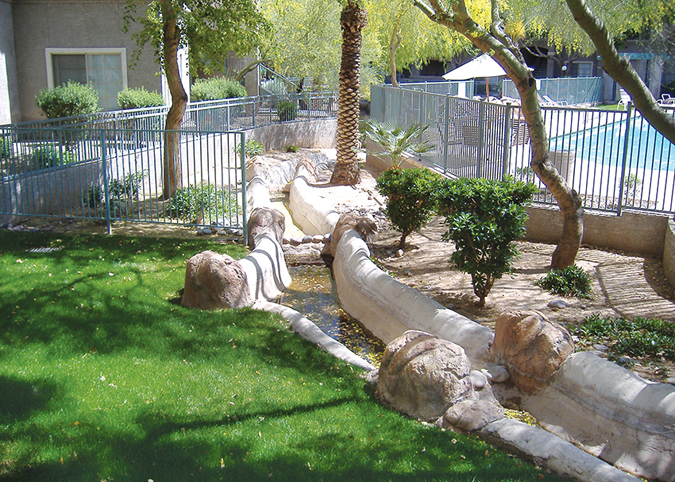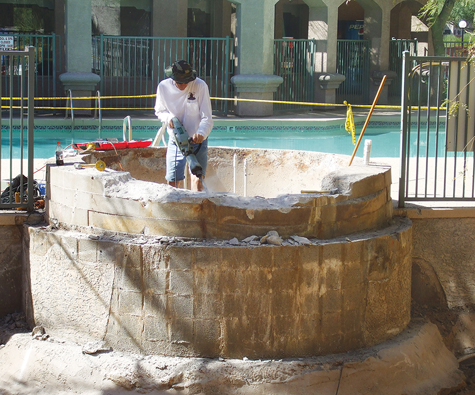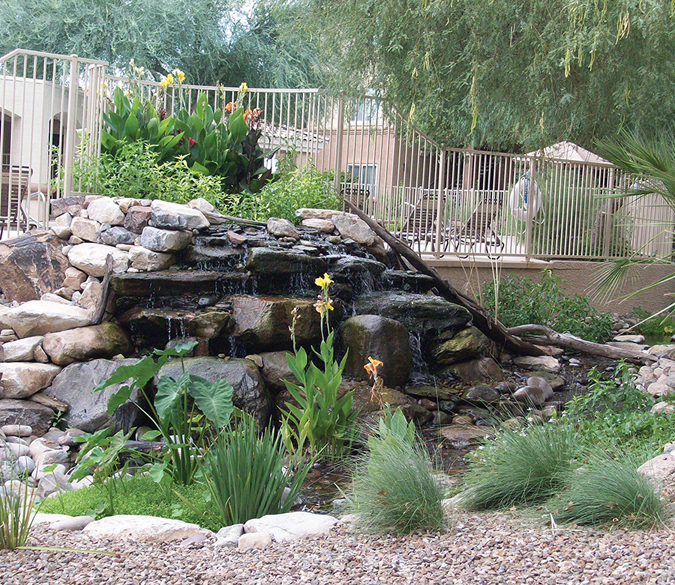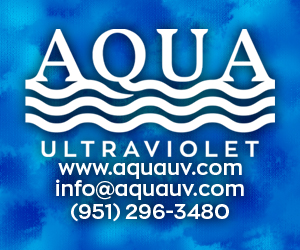
When a contractor turns on a pump, and water begins to flow over the top edge of an urn, scupper or stack of boulders, the client is immediately thrilled. It is one of the truths of our industry that if an installation is functional on the first day — and the client pays for it — the contractor can consider it a success. What happens after the first few months is of little consequence to far too many who dabble in the industry.
Sustainability is a word that gets thrown around quite a bit. And yet, all too frequently we still come across features that become completely dysfunctional after only a couple of months in use. It is not exactly a tribute to sustainability when an expensive project needs remodeling — or even a complete rebuild — in less than a decade. At The Pond Gnome, we believe that sustainability is defined by a feature that stands the test of time. This is why I want to crow about an 8-year-old commercial pond project that we are really proud of, rather than one of our more recent installations.
This story begins in 2007 when we got a call from The Regents at Scottsdale apartment complex in Scottsdale, Arizona, asking us to make repairs to their “koi pond,” which was built in a stormwater retention area at the center of the complex. What they really had was a 2-foot-deep concrete shell with an external pump and sand filter. Stormwater would roll off the surrounding parking lots and fill the retention basin. After every rain event , all the koi would die — go figure!We spent a lot of time over the course of many meetings determining the most important aspects and goals of their water feature. We came up with a design that captured about 4,000 gallons of each stormwater event and filtered it biologically as it flowed over the various waterfalls and stream courses. Because easier maintenance was one of their goals, we went with a living stream design instead of a koi pond. We recommended using cheap, “feeder” goldfish to stock the stream pools between rain events, figuring the fish would die from the runoff water after each storm event. Then, it was time to get started.
Tackling Challenges
Because the project was to be built in the center of an existing apartment complex, dedicated access and the lack of real estate for materials staging were both huge issues. We also had to work around the renters and the variety of sleep schedules and personalities. At that time, the scale of this project was the largest we had tackled. These issues presented some challenges that we easily overcame by calling in a couple of our pond -building colleagues from outside the Phoenix area. A tip of the hat to Scott Hammond of Aquascape by Blue Creek, who was instrumental in helping us complete the project within a timeline that made the client happy.

Once the dysfunctional feature was removed from the retention area, we began our project by installing a 2,000 -gallon, RainXchange cistern to service the 150-foot-long stream and 8-foot-tall waterfall, which would cascade adjacent to the pool area. The owners asked us to install the stream within the same footprint as the original feature, but we were able to convince them of some improvements to that plan. By shifting the headwater a few feet, we created stunning views from the spa and pool areas that didn’t exist previously. We also created enhanced views for many of the apartment balconies surrounding the area. One of the best pieces of advice I received early in my career as a water feature contractor was, “Give the client what they want, not what they ask for.” What every client wants is the best possible water feature for their setting, budget and goals.

The goals for this project included making the entire retention basin and surrounding area look and feel like a natural, riparian canyon. We also wanted to create a sustainable system that would require minimal maintenance. Finally, it was important that the feature would last decades in the face of significant stormwater runoff events and lots of foot traffic.
A Desert Oasis
The entire project was completed within six weeks. It includes a 150-foot living stream, four 10- to 15-foot-long pondless streams, an 8-foot-tall boulder waterfall and more than 400 feet of dry river beds used to direct water through the retention area to the five separate cisterns. These dry river beds also tie all the features together into one cohesive riparian canyon setting.
The project contains 4,000 gallons of stormwater-harvesting cisterns. We used eight pumps to circulate the water through six independent water features. We chose to use multiple pumps on the larger features so that a pump failure would not be an emergency during the summer months here in the desert. It’s much better to receive a “flow rate is down” service call, which can be handled in a couple of days, rather than a “drop what you are doing and get here right now” catastrophe. We brought in more than 400 tons of rock, ranging from 800 -pound boulders to 1- to 3-inch river cobble.
Mature trees fill the area to complete that riparian feel, and the birds that sing the praises of their urban riparian canyon are loved by residents and pool area visitors alike. It is difficult to imagine you are sitting in the middle of the Arizona desert while relaxing in this environment.
Reaping the Benefits

For those who wonder whether or not a well-built water feature can improve your property value, just ask the owner and management of The Regents at Scottsdale. They charge an $80 monthly premium to live in an apartment with a balcony view of this retention area. The waiting list to get into one of these “waterfront” apartments is quite long. Granted, funding for projects like this is not possible if the client does not believe that the $200,000 investment is worth creating a sustainable, easy-to-maintain, long-lived water feature. Needless to say, the answer in Scottsdale, Arizona, is a resounding YES!
Also, lo and behold! We even surprised ourselves when we discovered that the biological filtration system we set up was more than adequate to remove the pollutants and allow fish to survive the storm events and pollutant infusions. Needless to say, the owners and management — as well as several residents that consider the water feature their own personal oasis — were thrilled! And so were we.
This story had a happy ending. However, many poorly designed and constructed features often get filled in by someone who will never fund another water feature project. Most features that are overly complicated to maintain, overwhelming for the setting, poorly constructed or just plain ugly will scare people away. This is why we believe that it’s important to strive to fill our markets with well-designed and well-built water features that meet expectations over decades of service. Rock On!



